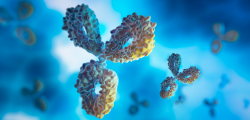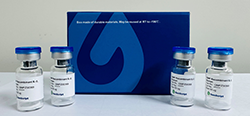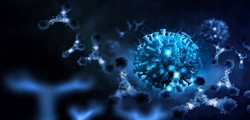| Description |
The clustered regularly interspaced
short palindromic repeats, known as CRISPR systems are adaptive immune mechanisms commonly present in
archaea and bacteria. The CRISPR systems enable the host to specifically target and cleave foreign
nucleic acids thus targeting infectiousviruses and plasmids. Recently, a type V CRISPR system has been
identified in several bacteria, the Cpf1 CRISPR from Prevotella and Francisella 1. In contrast to Cas9
systems, CRISPR/Cpf1 systems are smaller in size, do not require an additional trans-activating crRNA
(tracrRNA), and allow for targeting of additional genomic regions by cleaveing the target DNA proceeded by
a short T-rich protospacer-adjacent motif (PAM). On the other hand, the Cas9 system requires a G-rich PAM
following the target DNA. Furthermore, Cas12a/Cpf1 introduces a staggered DNA double stranded break
with a 4 or 5-nt 5’ overhang. Recombinant Acidaminococcus sp. BV3L6 Cas12a (cpf1) nuclease is
expressed in E. coli and purified. The nuclease contains nuclear localization sequence (NLS) at the
C-terminus and 6× His-tag at the C-terminus. |
| Key Features |
High knockout
efficiencies: Consistent high performance in in-vitro plasmid
cleavage test.
Time-saving: no need for transcription and translation.
DNA-free: no external DNA added to system. |
crRNA
-dependent double-stranded DNA cleavage.
|
| Source |
Recombinant
Cas12a with an C-terminal NLS expressed by E.coli. |
| Species |
Acidaminococcus sp.
(strain BV3L6)
|
| Tag |
C-terminal 6× His Tag
|
| Apparent Molecular Weight |
~150
kDa, on SDS-PAGE
under reducing conditions. |
| Concentration |
4(±10%) mg/ml
|
| Active temperature |
This Cas12a is active at 37℃.
|
| Storage Buffer |
20 mM Sodium Acetate, 500 mM NaCl, 1 mM TCEP,0.1 mM EDTA, 50% glycerol, PH6.0. |
| Storage & Stability |
This product remains stable up to 18 months at -20℃. Avoid repeated freeze-thaw
cycles. |
| Accession# |
U2UMQ6
|
| Appearance |
Clear, colorless liquid
|
| Purity |
≥ 90% by SDS-PAGE
|
| Concentration |
4(±10%) mg/m
|
| Bioactivity |
≥ 90%
|
| Residual DNase |
Undetectable
|
| Residual RNase |
Undetectable
|
| Endotoxin Level |
≤ 0.1 EU/μg of the protein by gel clotting method
|

A 20 μl reaction in 1xCas12a Nuclease Reaction Buffer containing 60 ng linearized plasmid, 10 ng crRNA, and 100 ng GenCRISPR™ Cas12a (Cpf1) Nuclease for 30 mins at 37°C results in a digestion efficiency of linearized plasmid higher than 90%, as determined by agarose gel electrophoresis.
| References |
1.
Zetsche,
Bernd, et al. "Cpf1 is a single
RNA-guided endonuclease of a class 2 CRISPR-Cas system." Cell 163.3
(2015): 759-771.
2.
Ledford, Heidi. "Alternative
CRISPR system could improve genome editing." Nature News 526.7571 (2015): 17.
3. “Cpf1 Takes CRISPR Bigger by GoingSmaller.” |
For
laboratory research use only. Direct human use, including taking orally and
injection and clinical use are forbidden.




































